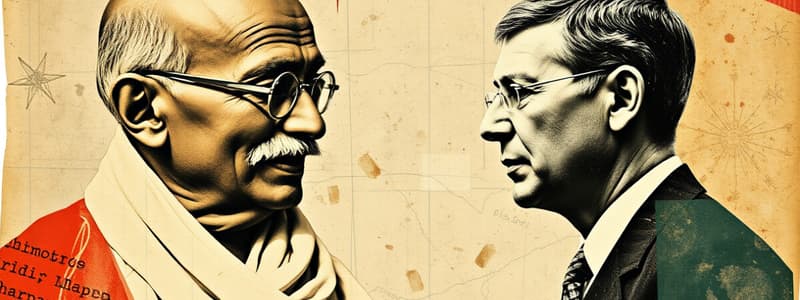Podcast
Questions and Answers
What was the outcome of the Gandhi-Irwin Pact?
What was the outcome of the Gandhi-Irwin Pact?
- End prosecutions
- Permit peaceful picketing
- Suspension of the Civil Disobedience Movement
- All of the above (correct)
Who was the sole representative of the Congress at the Second Round Table Conference?
Who was the sole representative of the Congress at the Second Round Table Conference?
Gandhiji
The Non-Cooperation Movement achieved all of its main demands.
The Non-Cooperation Movement achieved all of its main demands.
False (B)
The Non-Cooperation Movement transformed the Indian National Congress into an organization for ______.
The Non-Cooperation Movement transformed the Indian National Congress into an organization for ______.
Which of the following was a significant impact of the Non-Cooperation Movement?
Which of the following was a significant impact of the Non-Cooperation Movement?
Match the following impacts of the Non-Cooperation Movement:
Match the following impacts of the Non-Cooperation Movement:
What was one goal of the Khilafat Movement?
What was one goal of the Khilafat Movement?
Flashcards are hidden until you start studying
Study Notes
The Gandhi-Irwin Pact
- Signed in March 1931 between Gandhiji and Lord Irwin, following negotiations due to the ineffectiveness of the Satyagraha.
- The British Government's commitments included withdrawing all ordinances, releasing political prisoners (except those guilty of violence), allowing peaceful picketing, restoring confiscated properties of satyagrahis, and permitting salt collection near the coast.
- The Indian National Congress agreed to suspend the Civil Disobedience Movement, participate in the second Round Table Conference, and refrain from investigating police excesses.
Second Round Table Conference (September 7 - December 1, 1931)
- Gandhiji represented the Congress at the conference, set under the terms of the Gandhi-Irwin Pact.
- Conference discussions deadlocked over demands for separate electorates from various minority groups, including Muslims, Depressed Classes, and others.
- The British government did not grant immediate dominion status or independence, disappointing Gandhiji.
Impact of the Non-Cooperation Movement
- The movement aimed for Swaraj, an apology for the Jallianwala Bagh massacre, and the resolution of the Khilafat issue but did not achieve these goals.
- Transitioned the Indian National Movement into a mass movement involving peasants, workers, students, women, and teachers, despite resistance from industrialists and zamindars.
- Instilled confidence among Indians, encouraging defiance against colonial rule; historian Bipin Chandra emphasized its role in fostering self-esteem.
- Transformed the Congress from a deliberative body into a revolutionary entity, capable of leading mass mobilization for India's national struggle.
- Encouraged Hindu-Muslim unity through the alignment of the Khilafat issue with Congress objectives, fostering a sense of shared national identity among urban Muslims.
- Promoted social reforms, leading to prohibition efforts, the removal of untouchability, and the establishment of national schools; khadi symbolized the national movement's ideals.
- Enhanced nationalism across India; the Congress restructured to operate continuously and effectively, reducing membership fees to promote inclusivity.
- Popularized the concept of Swaraj, emphasizing grassroots support, bringing India closer to self-governance despite the movement not achieving immediate political goals.
The Khilafat Movement
- Aimed to secure sufficient territory for the Caliph and safeguard Islamic interests, focusing on Arab lands including regions like Arabia and Syria.
Studying That Suits You
Use AI to generate personalized quizzes and flashcards to suit your learning preferences.




